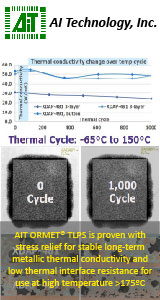|

|
|
| Ask the Experts | |||||||
|
|||||||
|
June 22, 2018 - Updated December 6, 2010 - Originally Posted BGA Rework Residue ConcernSometimes after removing a BGA for rework we see an outline of residue on the laminate around the pads. This residue is not easily washed off so we carefully scrape off the residue with a knife. Is it necessary to remove this residue before we install the new BGA? J. C. |
|||||||
| Expert Panel Responses | |||||||
|
The residue is most likely flux residue, if this is the case the question is best addressed to your paste supplier as they will have the relevant reliability data (it is a no clean product that you are using then most flux systems will withstand multiple reflow cycles without adverse impact on the reliability of the residues). One further point if your rework flux is different to the original you should consider possible flux interactions it is not common but can happen. If the residue is not flux then you will need to identify it before its impact on reliability, and consequently the need to remove it, can be determined.
Senior Applications Chemist Henkel Electronics Dr. Poole is a Senior Applications Chemist in Henkel Technologies, electronics assembly materials application engineering group. He is responsible for all of Henkel's assembly products including soldering products, underfills, PCB protection materials, and thermally conductive adhesives.
This sounds like flux residue from either the original process or flux being added during the rework operation. Contact the manufacturer of your solder paste or flux and find out the correct cleaner to use to remove this residue. "Careful" scraping may lead to PCB damage.
Regional Sales Manager OK International Inc. Ed Zamborsky is a Regional Sales & Technical Support Manager for Thermaltronics, located in New York. His position requires frequent customer visits throughout North America and the Caribbean and his position encompasses not only sales but the role of trainer and master applications engineer for all of Thermaltronics products. His expertise includes such specialties as hand soldering, convection and conduction reflow techniques, array rework, fluid dispensing equipment, and fume extraction. Ed has authored many articles and has presented many papers on topics such as; Low Volume SMT Assembly, Solder Fume Extraction, SMT Rework, BGA Rework, Lead-Free Hand Soldering, High Thermal Demand Hand Soldering, Lead Free Visual Inspection and Lead Free Array Rework.
It's hard to be sure if the contamination will cause problems or not, since you are not sure of the nature of the contamination. If it's flux residues -- the most likely candidate -- they there is a high probability the residues will react with the solder balls on the BGA and over time cause problems. (The most common problems are tin whiskers and corrosion, both of which are bad news on today's tightly-spaced BGA components.) So, for reliability's sake, I would urge you to clean the substrate with a modern, high-purity cleaning fluid. Many companies make such products; from my own company I would recommend PowerClean lead-free defluxer, because it's strong, fast-drying and nonflammable. As a general rule, stay away from the flammable cleaners in this application because they usually will not have the cleaning muscle to remove temperature-hardened residues.
Vice President Micro Care Mr. Jones is an electronics cleaning and stencil printing specialist. Averaging over one hundred days a year on the road, Mike visits SMT production sites and circuit board repair facilities in every corner of the globe, helping engineers and technicians work through the complex trade-offs today's demanding electronics require.
My guess is that this polymerized flux residue. If you clean after initial soldering, thisresidue was there after cleaning and was hidden. When you replace the BGA the new flux should redissolvethe residue which would then be cleanable, if you clean after rework, orencapsulate the residue if you do not clean. In any case, I believe you risk more harm byscraping it off so I would leave it alone.
President Austin American Technology Founder and President of AAT. Steve holds numerous patents and has authored numerous research papers and articles in cleaning and soldering. Steve is a founding member of the Central Texas Electronics Association and is a past Director of IMAPS. Steve is active on several IPC cleaning committees.
The residue is most likely flux. Do you use any bonding agents or under-fill on the component? Those can also be causes for this residue. The good manufacturing practice is to clean the pads solder) and the adjacent areas for any residue. Usually this cleaning process is relatively simple and the outcome is good. If you have so much trouble with it try to use some chemicals - you have some recommendations already. I will have another question - are you sure that this is not from the flux on your initial reflow process? Is your cleaning process efficient for low profile components?
Engineering and Operations Management Independent Consultant Georgian Simion is an independent consultant with 20+ years in electronics manufacturing engineering and operations.
Contact me at georgiansimion@yahoo.com. |
|||||||
| Submit A Comment | |||||||
|
Comments are reviewed prior to posting. You must include your full name to have your comments posted. We will not post your email address. |
|
Free Newsletter Subscription
Circuitnet is built for professionals who bear the responsibility of looking ahead, imagining the future, and preparing for it. Insert Your Email Address |
|

|






